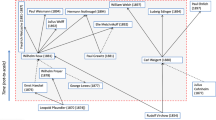Abstract
In multicellular systems the dif-ferentiation process has two interrelated but often separately studied components; the activation of special genes and the development of cellular specialization. The immune system, the model under consideration in this symposium, is no exception. Antibodies (or immunoglobulins) are controlled by a large number of structural genes that are expressed in perhaps the most highly specialized cellular system in the vertebrate organism. The elucidation of mechanisms whereby this differentiated function develops presents intriguing problems for both immunologist and developmental biologist. Many immunologists and, I am sure, biologists outside this field have been impressed with the seemingly new and exceptional mechanisms of cellular and gene differentiation in the immune system: e.g., clonal (VL, VH) specialization, the 2 gene:1 polypeptide chain relationship for immunoglobulin polypeptide chains, autosomal allelic exclusion, clonal selection, cell cooperation. These unusual mechanisms may have made the immune system at first an unattractive model for the developmental biologist; however as these processes become more familiar they can be appreciated for what they are: evolutionary exploitations of biological processes that have been modified to create a genetic and cellular system of defense for the vertebrate organism.
Access this chapter
Tax calculation will be finalised at checkout
Purchases are for personal use only
Preview
Unable to display preview. Download preview PDF.
Similar content being viewed by others
References
Basten, A., J. Miller, J. Sprent and J. Pye. A receptor for antibody on B lymphocytes. I. Method of detection and functional significance. J. Exptl. Med. 135: 610–626, 1972.
Basten, A., N. L. Warner and T. Mandel. A receptor for antibody on B lymphocytes. II. Immunochemical and electron microscopy characteristics. J. Exptl. Med. 135: 627–647, 1972.
Bianco, C., R. Patrick and N. Nussenzweig. A population of lymphocytes bearing a membrane receptor for antigen-antibody-complement complexes. I. Separation and characterization. J. Exptl. Med. 132: 702–720, 1970.
Blomberg, B., W. R. Geckler and M. Weigert. Genetics of the antibody response to dextran in mice. Science 177: 178–180, 1972.
Coutinho, A., E. Gronowicz, W. W. Bullock and G. Möller. Mechanisms of thymus independent immunocyte triggering. Mitogenic activation of B cells in specific immune responses. J. Exptl. Med. 139: 74–92, 1973.
Coutinho, A., and G. Moller. B-cell mitogenic properties of thymus independent antigens. Nature New Biol. 245: 11–14, 1973.
Dreyer, W. J., and J. D. Bennett. The molecular basis of antibody formation: a paradox. Proc. Natl. Acad. Sci. U.S. 54: 864–869, 1965.
Dreyer, W. J., W. R. Gray and L. Hood. The genetic, molecular and cellular basis of antibody formation: some facts and a unifying hypothesis. Cold Spring Harbor Symp. Quant. Biol. 32: 353–368, 1967.
Dukor, P., and K. U. Hartmann. Hypothesis. Bound C3 as the second signal for B-cell activation. Cell. Immunol. 7: 349–356, 1973.
Feldmann, M., and G. J. V. Nossal. Tolerance enhancement and the regulation of interactions between T cells, B cells and macrophages. Transplant. Rev. 13: 3–34, 1972.
Gally, J. A. Structure of immunoglobulins. In: The Antigens, edited by M. Sela. New York: Academic, 1973, p. 161–298.
Harboe, M., C. K. Osterland, M. Mannik and H. G. Kunkel. Genetic characters of human y-globulins in myeloma proteins. J. Exptl. Med. 116: 719–738, 1962.
Hood, L., D. Mckean, V. Farnsworth and M. Potter. Mouse immunoglobulin chains. A survey of the amino terminal sequences of K chains. Biochemistry 12: 741, 1973.
Lieberman, R., M. Potter, E. B. Mushinski, W. Humphrey, JR. and S. Rudikoff. Genetics of a new IgVH (T15 idiotype) marker in the mouse regulating natural antibody to phosphorylcholine. J. Exptl. Med. 139: 983 1001, 1974.
Mage, R., R. Lieberman, M. Potter and W. D. Terry. Immunoglobulin allotypes In: The Antigens, edited by M. Sela. New York: Academic, 1973, P. 299–376.
Mitchison, N. A., R. Taylor and K. Rajewsky. Cooperation of antigenic determinants in the induction of antibodies. In: Development aspects of antibody formation and structure, edited by J. Sterzi. Prague: Czech. Acad. Sci. 1970, p. 547.
Moller, G. Effect of B-cell mitogens on lymphocyte subpopulations possessing C3 and Fc receptors. J. Exptl. Med. 139: 969–982, 1974.
Möller, G., O. Sjoberg and J. Anders-Son. Immunogenicity, tolerogenicity and mitogenicity of lipopolysaccharides. J. Infect. Diseases 128: Suppl, S52 - S56, 1973.
Pawlak, L. L., E. B. Mushinski, A. Nisonoff and M. Potter. Evidence for the linkage of the IgCH locus to a gene controlling the idiotypic specificity of anti-p-azophenylarsonate antibodies in strain A mice. J. Exptl. Med. 137: 22–31, 1973.
Potter, M. Immunoglobulin-producing tumors and myeloma proteins of mice. Physiol. Rev. 52: 631–719, 1972.
Premkumar, E., M. Shoyab and A. R. Williamson. Germline basis for antibody diversity IgVH and CH gene frequencies measured by DNA:RNA hybridization. Proc. Natl. Acad. Sci. U.S. 71: 99–103, 1974.
Shevach, E., R. Herberman, R. Lieber-Man, M. M. Frank and I. Green. Receptors for immunoglobulin and complement on mouse leukemias and lymphomas. J. Immunol. 108: 325–328, 1972.
Warner, N. L., L. A. Herzenberg and G. Goldstein. Immunoglobulin isoantigens (allotypes) in the mouse. II. Allotype analysis of three yG2-myeloma proteins from (NZB x BALB/c) F, hybrids of normal yG2-globulins. J. Exptl. Med. 123: 707–721, 1966.
Author information
Authors and Affiliations
Editor information
Editors and Affiliations
Rights and permissions
Copyright information
© 1975 Federation of American Societies
About this chapter
Cite this chapter
Potter, M. (1975). Introductory remarks. In: Thorbecke, G.J. (eds) Biology of Aging and Development. Faseb Monographs, vol 3. Springer, Boston, MA. https://doi.org/10.1007/978-1-4684-2631-1_5
Download citation
DOI: https://doi.org/10.1007/978-1-4684-2631-1_5
Publisher Name: Springer, Boston, MA
Print ISBN: 978-1-4684-2633-5
Online ISBN: 978-1-4684-2631-1
eBook Packages: Springer Book Archive




